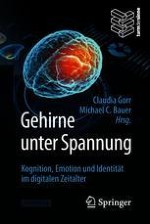2019 | OriginalPaper | Buchkapitel
Schule digital – Fokus Gehirn. Neurowissenschaftliche Erkenntnisse zur Wirkung neuer Medien
verfasst von : Emanuela Bernsmann
Erschienen in: Gehirne unter Spannung
Verlag: Springer Berlin Heidelberg
Aktivieren Sie unsere intelligente Suche, um passende Fachinhalte oder Patente zu finden.
Wählen Sie Textabschnitte aus um mit Künstlicher Intelligenz passenden Patente zu finden. powered by
Markieren Sie Textabschnitte, um KI-gestützt weitere passende Inhalte zu finden. powered by
